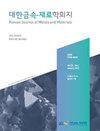Stretchable Energy Harvesting Device based on Thermoelectric Composite Films
IF 1.1
4区 材料科学
Q4 MATERIALS SCIENCE, MULTIDISCIPLINARY
引用次数: 0
Abstract
Thermoelectric energy harvesting has attracted a lot of attention for powering self-powered devices because of the potential to generate energy anywhere with a temperature difference. In particular, a stretchable thermoelectric generator (S-TEG) can be applied to the repetitively moving parts of a machine and even a human body. Herein, we suggested a S-TEG using thermoelectric composite films made by dispersing n-type Bi2Te2.7Se0.3 powders into the polyvinylidene fluoride elastomer. The prepared n-type thermoelectric composite film with 75 wt% of Bi2Te2.7Se0.3 powders showed a power factor of 1.81 mW m−1 K−2 at room temperature. Next, we fabricated S-TEG by encapsulating thermoelectric powders-based composite films, and Ag-coated textile electrodes with an Eco-flex matrix. The fabricated stretchable energy harvester generated a maximum output power of 2.35 nW at a temperature difference (ΔT) of 25 K. By repeatedly introducing ΔT=5K, our S-TEG converted the output voltage of 3.4 mV and current signals of 0.25 mA. Moreover, a finite element analysis with multiphysics COMSOL simulation software was conducted to compare the experimental and theoretical thermoelectric output performance of the fabricated S-TEG. Finally, we demonstrated energy harvesting by converting human body heat into electrical energy for potential utilization of our energy harvester. This study led to the development of a S-TEG design using thermoelectric film with a simple and low-cost fabrication procedure, providing a potential approach for use as a next-generation wearable device power source.基于热电复合膜的可伸缩能量采集装置
由于热电能在任何有温差的地方产生能量的潜力,热电能收集在为自供电设备供电方面吸引了很多关注。特别地,可拉伸热电发生器(S-TEG)可以应用于机器甚至人体的重复运动部件。在此,我们提出了一种使用热电复合膜的S-TEG,该热电复合膜是通过将n型Bi2Te2.7Se0.3粉末分散到聚偏二氟乙烯弹性体中而制备的。用75wt%的Bi2Te2.7Se0.3粉末制备的n型热电复合膜在室温下显示出1.81 mW m−1 K−2的功率因数。接下来,我们通过封装基于热电粉末的复合膜和具有Eco-flex基体的Ag涂层织物电极来制造S-TEG。所制造的可拉伸能量采集器在25 K的温差(ΔT)下产生了2.35 nW的最大输出功率。通过重复引入ΔT=5K,我们的S-TEG转换了3.4 mV的输出电压和0.25 mA的电流信号。此外,利用multiphysics COMSOL模拟软件进行了有限元分析,以比较所制造的S-TEG的实验和理论热电输出性能。最后,我们展示了通过将人体热量转化为电能来获取能量的方法,以充分利用我们的能量采集器。这项研究开发了一种使用热电薄膜的S-TEG设计,该设计具有简单和低成本的制造程序,为用作下一代可穿戴设备电源提供了一种潜在的方法。
本文章由计算机程序翻译,如有差异,请以英文原文为准。
求助全文
约1分钟内获得全文
求助全文
来源期刊

Korean Journal of Metals and Materials
MATERIALS SCIENCE, MULTIDISCIPLINARY-METALLURGY & METALLURGICAL ENGINEERING
CiteScore
1.80
自引率
58.30%
发文量
100
审稿时长
4-8 weeks
期刊介绍:
The Korean Journal of Metals and Materials is a representative Korean-language journal of the Korean Institute of Metals and Materials (KIM); it publishes domestic and foreign academic papers related to metals and materials, in abroad range of fields from metals and materials to nano-materials, biomaterials, functional materials, energy materials, and new materials, and its official ISO designation is Korean J. Met. Mater.
 求助内容:
求助内容: 应助结果提醒方式:
应助结果提醒方式:


